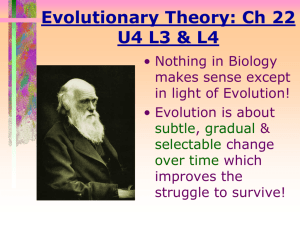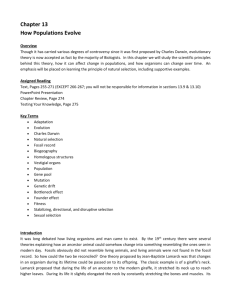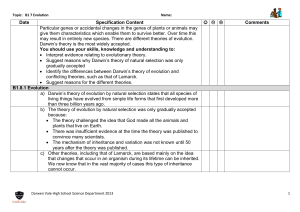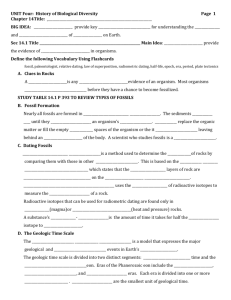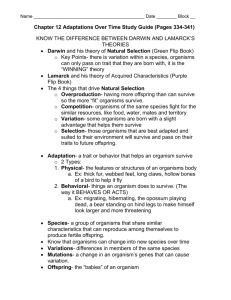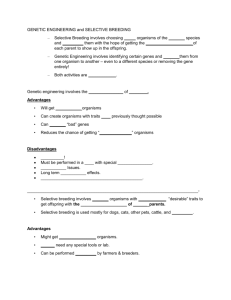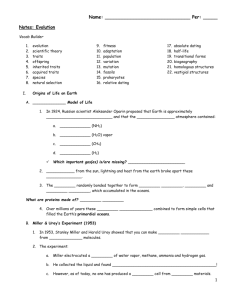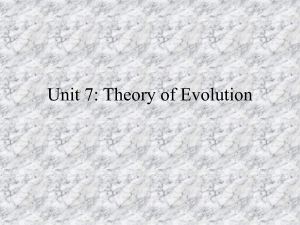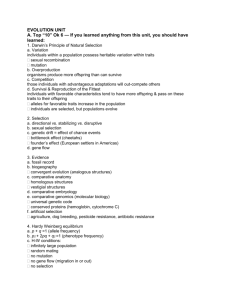EVOLUTION STUDY GUIDE The process by which modern
advertisement
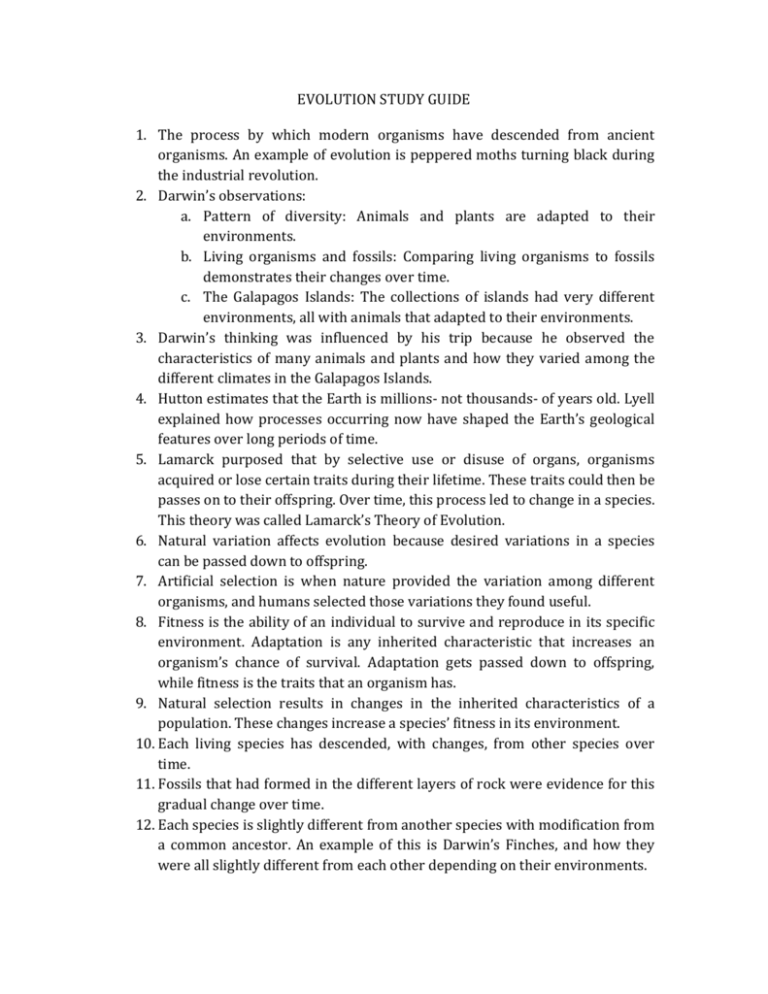
EVOLUTION STUDY GUIDE 1. The process by which modern organisms have descended from ancient organisms. An example of evolution is peppered moths turning black during the industrial revolution. 2. Darwin’s observations: a. Pattern of diversity: Animals and plants are adapted to their environments. b. Living organisms and fossils: Comparing living organisms to fossils demonstrates their changes over time. c. The Galapagos Islands: The collections of islands had very different environments, all with animals that adapted to their environments. 3. Darwin’s thinking was influenced by his trip because he observed the characteristics of many animals and plants and how they varied among the different climates in the Galapagos Islands. 4. Hutton estimates that the Earth is millions- not thousands- of years old. Lyell explained how processes occurring now have shaped the Earth’s geological features over long periods of time. 5. Lamarck purposed that by selective use or disuse of organs, organisms acquired or lose certain traits during their lifetime. These traits could then be passes on to their offspring. Over time, this process led to change in a species. This theory was called Lamarck’s Theory of Evolution. 6. Natural variation affects evolution because desired variations in a species can be passed down to offspring. 7. Artificial selection is when nature provided the variation among different organisms, and humans selected those variations they found useful. 8. Fitness is the ability of an individual to survive and reproduce in its specific environment. Adaptation is any inherited characteristic that increases an organism’s chance of survival. Adaptation gets passed down to offspring, while fitness is the traits that an organism has. 9. Natural selection results in changes in the inherited characteristics of a population. These changes increase a species’ fitness in its environment. 10. Each living species has descended, with changes, from other species over time. 11. Fossils that had formed in the different layers of rock were evidence for this gradual change over time. 12. Each species is slightly different from another species with modification from a common ancestor. An example of this is Darwin’s Finches, and how they were all slightly different from each other depending on their environments. 13. A vestigial organ is a homologous structure that serves no important function anymore. An appendix is vestigial organ. 14. Embryos form different species are developed in the same order and in similar patters to produce the tissues, grow in similar ways, and produce homologous structures. 15. Summary of Darwin’s theory: a. Individuals in nature differ form each other. Some of these variations are inherited. b. Organisms in nature produce more offspring than can survive, and many of those that survive do not reproduce. c. Because more organisms are produced that can survive, members of each species more compete for limited resources. d. Because each organism is unique, 16. Because over time, insects will become immune to DDT and pass this gene down to offspring. 17. Because sexual reproduction can produce many different phenotypes, but it does not change the relative frequency of alleles in a population. 18. The number of phenotypes produced for a given trait depends on how many genes control the trait. 19. The traits controlled by a single gene. 20. Because it is the typical result of polygenic traits. 21. Natural selection on single-gene traits can lead to changes in allele frequencies and this to evolution. 22. Speciation is the formation of new species, while reproduction isolation is the separation of species or populations so that they cannot interbreed and produce fertile offspring. 23. Stabilizing selection is a form of natural selection by which the venter of the curve remains in its current position. Disruptive selection is a form of natural selection in which a single curve splits in two. 24. Genetic drift is the random change in allele frequency. In small populations, individuals hat carry a particular allele may leave more descendants than other individuals, just by chance. Over time, a series of chance occurrences of this type can cause an allele to become common in a population. 25. The situation in which allele frequencies remain constant. 26. Darwin observed the beak sizes and feeding habits of different Finches. 27. Natural selection shaped the birds beaks because they adapted to the bird’s environment. 28. Because if one individual contracts a virus, and all other individuals in that species have the same genes, it can be concluded that it is likely that all individuals are susceptible to the virus. 29. Relative dating allows paleontologists to estimate a fossils age compared with that of other fossils. 30. In radioactive dating, scientists calculate the age of a sample based on the amount of remaining radioactive isotopes it contains. 31. The geologic time scale is used to represent evolutionary time. Studying rock layers and index fossils worldwide helped develop the scale. 32. Earth’s early atmosphere was probably made of hydrogen cyanide, carbon dioxide, carbon monoxide hydrogen sulfide, and water. Eventually, Earth’s surface cooled enough for water to exist. Thunderstorms drenched Earth, and thus made oceans. 33. Miller and Urey produced amino acids, which are needed to make proteins, by passing sparks through a mixture of hydrogen, methane, ammonia and water. T6his experiment suggested how mixture of the organic compounds necessary for life could have arisen from simpler compounds present on s primitive Earth. 34. The rise of oxygen in the atmosphere drove some like forms to extinction, while other life forms evolved new, more efficient metabolic pathways that used oxygen for respiration. 35. The endosymbiosis theory proposes that eukaryotic cells arose from living communities formed by prokaryotic organisms. 36. Sexual reproduction allows for a larger gene pool within a species. 37. During the Cenozoic, mammals evolved adaptations that allowed them to live in various environments- on land, in water, and even in the air. 38. Earth began to warm, causing continental glaciers to melt, thus sea levels rose again. Mammals, fish, insects, and birds were able to thrive in a warmer climate. 39. Adaptive radiation is when living organisms show that a single species or a small group of species has evolved into several different forms that live in different ways. Even though camels, bats, elephants, rats and manatees are all mammals, they all have different environments that they have adapted to. 40. Punctuated equilibrium describes the pattern of a long, stable period interrupted by brief periods of more rapid change. An example of this would be that horses were small for a very long time; however, they have recently become the horses they are today. 41. Hox genes can reveal how evolution occurred by looking at molecular levels which reveal that homologues Hox genes establish body plans in animals as different as insects and humans.

